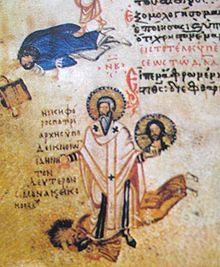Loading AI tools
Ecumenical Patriarch of Constantinople from 806 to 815 From Wikipedia, the free encyclopedia
Nikephoros I or Nicephorus I (Greek: Νικηφόρος; c. 758 – 5 April 828) was a Byzantine writer and patriarch of Constantinople from 12 April 806 to 13 March 815.[1][2]
Nikephoros of Constantinople | |
|---|---|
 Nikephoros I of Constantinople trampling on John VII of Constantinople. Miniature from Chludov Psalter. | |
| Ecumenical Patriarch of Constantinople | |
| Born | c. 758 Constantinople (modern-day Istanbul, Turkey) |
| Died | 5 April 828 Constantinople (modern-day Istanbul, Turkey) |
| Venerated in | Roman Catholic Church; Eastern Orthodox Church |
| Feast | 13 March, 2 June |
He was born in Constantinople as the son of Theodore and Eudokia, of a strictly Orthodox family, which had suffered from the earlier Iconoclasm. His father Theodore, one of the secretaries of Emperor Constantine V, had been scourged and banished to Nicaea for his zealous support of Iconodules,[3] and the son inherited the religious convictions of the father.
While still young Nikephorus was brought to the court, where he became an imperial secretary and entered the service of the Empire. Under Empress Irene he took part in the synod of 787 as imperial commissioner. He then withdrew to one of the cloisters that he had founded on the Thracian Bosporus. There he devoted himself to ascetic practices and to the study both of secular learning, as grammar, mathematics, and philosophy, and the Scriptures. Around 802 he was recalled and appointed director of the largest hospital for the destitute in Constantinople.[3]
After the death of the Patriarch Tarasios of Constantinople, there was great division among the clergy and higher court officials as to the choice of his successor. Although still a layman, Nikephorus was chosen patriarch by the wish of the emperor (Easter, 12 April 806). The uncanonical choice met with opposition from the strictly clerical party of the Stoudites,[3] and this opposition intensified into an open break when Nikephoros, in other respects a very rigid moralist, showed himself compliant to the will of the emperor by reinstating the excommunicated priest Joseph.
After vain theological disputes, in December 814, there followed personal insults. Nikephoros at first replied to his removal from his office by excommunication, but at last, under Leo V the Armenian was obliged to yield to force, and was taken to one of the cloisters he had founded, Tou Agathou, and later to that called Tou Hagiou Theodorou. From there he carried on a literary polemic for the cause of the iconodules against the synod of 815. On the occasion of the change of emperors, in 820, he was put forward as a candidate for the patriarchate and at least obtained the promise of toleration.
He died at the monastery of Saint Theodore (Hagiou Theodorou), revered as a confessor.[4] His remains were solemnly brought back to Constantinople by Methodios I of Constantinople on 13 March 847 and interred in the Church of the Holy Apostles, where they were annually the object of imperial devotion. His feast is celebrated on this day both in the Greek and Roman Churches; the Greeks also observe 2 June as the day of his death.
Compared with Theodore of Stoudios, Nikephoros appears as a friend of conciliation, learned in patristics, more inclined to take the defensive than the offensive, and possessed of a comparatively chaste, simple style. He was mild in his ecclesiastical and monastical rules and non-partisan in his historical treatment of the period from 602 to 769 (Historia syntomos, breviarium). He used the chronicle of Trajan the Patrician but deliberately chose not to name the source so as to connect himself to the historical tradition of Theophylact Simocatta.[5][6] The Short History is thematically focused around the matter of the offices of emperor and patriarch.[7] Nikephoros attempted to salvage the reputation of the patriarchate by criticizing iconoclast patriarchs for submitting to the emperor, not for being iconoclasts.[8] Herakleios was the ideal emperor in Nikephoros’ scheme because of how he worked alongside patriarch Sergios, but also how Sergios helped to defend Constantinople from the Avars in 626 as well as the patriarch’s ability to discipline the emperor for his marriage to his niece Martina. Herakleios failure to heed the Egyptian patriarch’s advice is what ultimately brought about the Arab conquest of Egypt.[9]
His tables of universal history, Chronography or Chronographikon Syntomon, in passages extended and continued, were in great favor with the Byzantines, and were also circulated outside the Empire in the Latin version of Anastasius Bibliothecarius, and also in Slavonic translation. The Chronography offered a universal history from the time of Adam and Eve to his own time. To it he appended a canon catalog (which does not include the Revelation of John). The catalog of the accepted books of the Old and New Testaments is followed by the antilegomena (including Revelation) and the apocrypha. Next to each book is the count of its lines, his stichometry, to which we can compare our accepted texts and judge how much has been added or omitted. This is especially useful for apocrypha for which only fragmentary texts have survived.
The principal works of Nikephorus are three writings referring to iconoclasm:
Nikephoros follows in the path of John of Damascus. His merit is the thoroughness with which he traced the literary and traditional proofs, and his detailed refutations are serviceable for the knowledge they afford of important texts adduced by his opponents and in part drawn from the older church literature.
Seamless Wikipedia browsing. On steroids.
Every time you click a link to Wikipedia, Wiktionary or Wikiquote in your browser's search results, it will show the modern Wikiwand interface.
Wikiwand extension is a five stars, simple, with minimum permission required to keep your browsing private, safe and transparent.